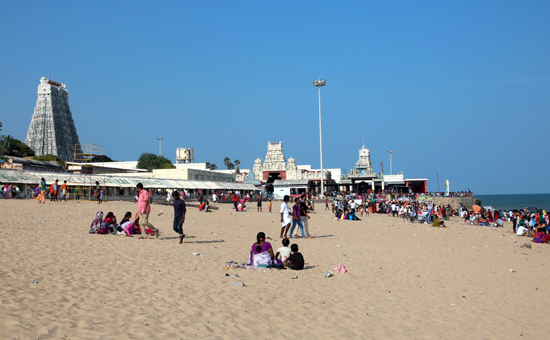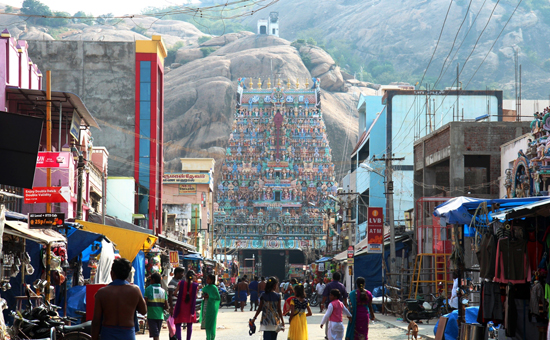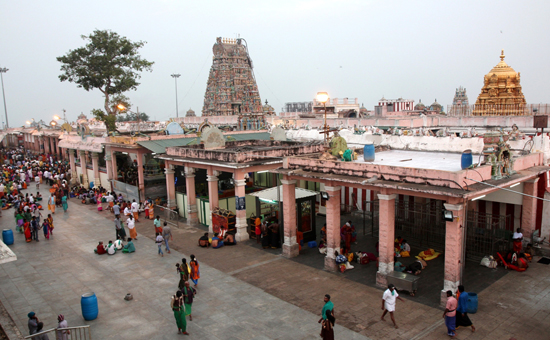Sri Muruga or Somaskanda
has been the popular and presiding deity of cultural Tamilakam. Tradition
eulogizes Murukan as ‘Tamizh Katuvul’ or Lord of Tamil and head of the second
Sangam. Although Agastya is designated head of the first Tamil Sankam, it is
traditionally believed that Murukan imparted Tamil to Agastya.
The concept of the deity that
is deep rooted in the socio-ecological framework of the five Thinais or zones
of the Sangam literature and its metamorphosis is a long process. The five
zones are kurunji or the hilly tracts, mullai or the pastoral
region, paalai or the desert land, neidhal or the coastal area
and the marudham or the riverine plains. It is significant to note that
each one of the zones was named after a flower unique to that area. In the
context of Tamilakam, sacred geography is invariably associated with the ‘Aaru
Patai Veetukal,’ i.e., Murukan’s six camps or
sacred sites. These sites are associated with particular episodes that
are spread across the Tamil cultural geography, effectively amalgamating the
landscape with the deity.
It is essential to
comprehend the importance Tamil literature attributed for Sri Murugan. This is
crucial to understand his significance in traditional knowledge systems of
Tamilakam. Tolkappiyam, possibly the most ancient of the extant
Sangam works, dated between the 3rd century BCE and 5th century CE glorified
Murugan, “the red god seated on the blue peacock, who is ever young and
resplendent,” as the favored deity of Tamilakam. The Cilappatikaram
(Anklet Story) eulogizes Muruga as the six-headed deity who slayed the demon
Sura. As narrated by the Tamil poet Nakīrar in his late Sangam period classic
of Murugan devotion, Tirumurugārrupadai, these abodes are
Tirupparamkundram, Tiruchendur, Tiruvavinankudi (Palani), Tiruverakam (Swami
Malai), Kundruthorādal (Tiruttani and several other hills) and Palamutircolai.
The tradition of narrating the four-fold landscape, rivers and ecology in later
texts has its origin in aaruppatai poems. There are five aaruppatai
poems in Pattupattu anthology of Sangam literature.
The poem, Tirumurugārrupadai,
attributed to Muruga was composed by renowned poet and scholar Nakīrar. It is
by far the most popular and longest devotional Tamil poem of the Sangam period.
It is still read by thousands of devout people throughout the length and
breadth of the Tamil-speaking world. This is considered to be the 11th book of
the sacred hymns of the Saivas, and with the devotees of Muruga it is a part of
their daily liturgy. Four shrines along with others of the god are described in
this poem. They are - Tiruparankunram, Tiruchiralaivai, Tiruvavinakudi and
Tiruverugam. It is interesting to note that all these shrines are situated on
hilltops.
The great Tamil poet and
saint, Avvaiyar is deeply associated with Pazhamudircholai temple of Murugan on
a thickly forested hill near Madurai. She is hailed as a devotee of Sri Murugan
who imparted Jnana or spiritual knowledge to her. Annual Avvai Vizha is
conducted by the Government of Tamil Nadu to commemorate Avvaiyar’s contribution
to Tamil literature.
Navamanikal composed by Arunagirinatha,
Kantha Purana by Kachiyappa Sivacharya, Thiruchendur Kanthar Kalivenpa by
Kumara Gurupadar, Kanthar Shashti Kavacha by Devaraya Swami, Shanmukha Kavacha
by Pamban Swami, and Skanda Guru Kavacha by Santhananda Swami are classical
Tamil stotras on Muruga/Somaskanda.
 Murugan Temple Tiruchendur
Murugan Temple Tiruchendur
Poyamoli Pulavar or Siva
Kavi, Pakalli Koottar, Murugammaiyar, Arunagirinathar and Kumaragurupara
Swamigal are other important saints of Sri Muruga in Tamilakam. In the
historical study of Tevaram hymns, Sambandar has observed that the ladies in
the hilly regions used to gather and sing songs in praise of Muruga. Sundarar
eulogizes that Muruga is young and extremely handsome. Appar has explained
Muruga’s marriage with Valli, the hunter girl. The Kurava hunter-gatherer
people of the Sangam Period were ardent devotees of Muruga. It also shows the
amalgamation of the hunting gathering and agricultural traditions in the
historical development of Tamilakam. One of the foremost social reformers and
spiritual saints of Kerala, Sri Narayana Guru,
composed two Sanskrit and five Malayalam stotras eulogizing Sri Muruga.
He also established many temples for the deity in Kerala.
Traditional knowledge
systems play an important role in the conservation of sacred elements such as
place names and its ecological significance, sacred grove, sacred tree and
remnant tree worship. In ancient Tamilakam, the concept of kaaval marangal
(protecting trees) was prevalent. Ancient Tamil society preserved the social,
economic, medicinal and environmental importance of these plants. Traditional
knowledge systems in ancient Tamilakam are deeply associated with Sri Muruga.
Sri Muruga is
hailed as the deity of Siddha medication. Sangam
literature hails him the Lord of Kurinji (hilly tracts) where there are lot of
medicinal trees and plants. Apart from mango tree and lotus plant, the various
trees attached to Muruga/Somaskanda temples include Marudham or Queen’s Flower
(Terminalia Arjuna), Panneer or Indian Lavender (Guettarda speciosa),
Punnai or Alexandrian Laurel (Calophyllum inophyllum), Nelli or
gooseberry (Emblica officinalis), Mahizham (Mimusops elengi),
Pala or jackfruit tree (Artocarpus integrifolia), Kura (Webra
corymbosa), Padhiri (Stereospermum suaveolens), Vanni (Prosopis
spicigera) and Kal Athi (Ficus retusa auct). Scholars have
undertaken their study in the botanical and cultural context.
 Murugan Temple near Madurai
Murugan Temple near Madurai
Muruga temples in Tamilakam
are famous in their ecological context of sacred groves and medicinal gardens.
Marudham is the sacred tree in the Dandayudhapani temple at Marudamalai in
Coimbatore. Panner is very sacred to Murukan in Tiruchendur on seashore. The
Punnai tree is the sthala vriksha at Somaskanda temple in Mayilam.
Mahizham is the sthala vriksha of Śrī Kandaswamy temple at
Tirupporur in Kanchipuram and Śrī Kulandaivel temple at Poombarai in Madurai.
Kura or Bottle Brush tree is the sthala vriksha of the
Kumarasivam temple at Tiruvidaikali in Nagapattinam. Kal-Athi or Narrow Leaved
Fig is the sacred tree in Tirupparankunram, the first of six abodes of the Lord
near Madurai. The temple of Chennimalai situated on the banks of Noyyal is
famous for its rare medicinal herbs and trees.
Kumārasaṃbhavam, the epic Sanskrit poem on the birth of Muruga, was composed by
Kālidāsa who lived in Ujjain in Central India. The poem is widely regarded as
one of Kālidāsa’s finest works, a paradigmatic example of kāvya poetry. Ujjain
is a known pilgrimage centre with the Kumbh Mela known as Simhastha held here
every 12 years. Ujjain continues to be an important
place of pilgrimage for Shaivites, Jains, Buddhists and Shaktas. An
ancient city situated on the eastern bank of the Kshipra River, Ujjain was the
most prominent city on the Malwa plateau of central India for much of its
history. It emerged as the political centre of central India around 600 BCE. It
was the capital of the ancient Avanti kingdom, one of the sixteen
Mahajanapadas. In his classic, Meghadūta, Kalidasa describes the
prosperity of Ujjain and its people. Ujjain also appears in several stories as
the capital of the legendary emperor Vikramaditya.
Ujjain emerged as an
important commercial centre, partly because it lay on the trade route
connecting north India to the Deccan, starting from Mathura in Ganga-Yamuna
doab. It links central India with south as far as Kaveri basin. The land routes
from Godavari basin in central India and Godavari-Krishna delta transcending
the Raichur doab connects Madurai and Thirunelveli regions in Tamilakam. Thus
Uttarapatha and Dakshinapatha emerged as two ancient trade routes of India,
during the Maurya Period. It also shows the long and continuous process of
mutual cultural interaction between Ganga Plains, Central India and Kaveri
delta for nearly three millennia. The Cilappatikaram mentions Ujjain and
Vindhya region.
The Atharva Veda describes
Muruga or Somaskanda as ‘Agnibhuh’ or son of Agni, the fire god. The
Satapatha Brahmana refers to him as the son of Rudra and the ninth form of
Agni. The Taittiriya Aranyaka contains the Gayatri mantra for Shanmukha. The
Chandogya Upanishad refers to Skanda as the “way that leads to wisdom”. The
Baudhayana Dharmasutra mentions Skanda as ‘Mahasena’ and ‘Subrahmanya.’ The
Aranya Parva canto of the Mahabharata relates the legend of Kartikeya Skanda in
considerable detail. The Upanishads also constantly make reference to Guha, the
indweller. In the Bhagavad Gita belonging to post-Upanishadic period, Krishna,
explaining his omnipresence, says: “Among generals, I am Skanda, the lord of
war.” (Ch.10, Verse 24) Muruga has been extensively referred in Puranas such as
Markandeya and Skanda. The Skanda Purana is devoted to the narrative of
Somaskanda.
 Murugan Temple Palani
Murugan Temple Palani
The iconography of Sri
Muruga is elaborated at length in the texts, Kumaratantra and Śritattvanidhi. The Śritattvanidhi associates the other forms of Muruga
like Kartikeya, Shanmukha and Desika with the peacock. They are ten,
twelve and six-handed respectively. Iravatham Mahadevan emphasizes the
historical tradition that Sanskrit and Tamil emerged from the two sides of the damaru
(drum) of Shiva which presents in all contemplation the antiquity and equal
divine status accorded in our tradition to the two languages recognized as
classical (An epigraphic perspective on the antiquity of Tamil, The
Hindu, June 24, 2010).
Siddha
medicine is a system of traditional medicine originating in ancient Tamilakam
and associated with Muruga. There were 22 principal
siddhars. Of these 22, Agastya is believed to be the father of siddha medicine.
The siddha system is believed to have been handed over to him by Murugan. The
Siddhars were mainly responsible for the growth and development of Tamil
medicine such as alchemy, medicine, Kundalini yoga, kayakalpa (rejuvenation
therapy), varma, muppu, and thokkanam. The teaching was imparted in the form of
verses, many of them in ambiguous language and handed down to posterity by
guru-sishya (teacher-disciple) tradition of ancient India.
Nava pashanam, the image of Sri Muruga at Palani, is one of the most acclaimed Siddha
elixirs. It is made of navapashanam - nava meaning nine and pashanam
meaning mineral or poison. The amalgam of nine minerals is believed to have
been made by Bhogar, a sage, using a unique formula. The panchamritham,
of milk, honey and other materials used for abhishekam on the idol is believed
to absorb the navapashanam, and hence the belief that it contains
curative properties.
Murugan is presiding deity
of zodiacal representation in the astronomical connotation. His important
festivals fall in the areas representing the twelve rasis or solar
months. Hence he is immensely worshipped by astrologers in South India,
especially Kerala and Tamil Nadu. There is a six day period of fast and prayer
in the Tamil month of Aippasi known as the Skanda Shasti. He is worshipped at
Thaipusam, celebrated by Tamil communities worldwide near the full moon of the
Tamil month Thai.
Murugan is
also deity of traditional potter families and iron smelting communities in
Tamilakam. Artisans and craftsmen in pottery, terracotta, bronze, textiles, jewellery, temple architecture, traditional stone cutlery and stone carvings are also immensely devoted to him. South Indian bronzes, especially belonging to Chola Period are renowned for their technology. The Chola image of Somaskanda, Shiva with Uma and Muruga are unique and popular. Somaskanda images are reported from many sites such as Pallavanīśvaram, Tirutturaippūņṭi, Vaittīcuvaran Kōvil, Kunnandar Kovil, Nidur, Mamallapuram and Kāñchipuram. The Tamil month Panguni (mid-March to mid-April) is the month of the temple festival popularly known as ‘Brahmotsavam,’ and the central processional image is Somaskanda.
An active
agenda is working to uproot Sri Murugan and exterminate his tradition from the
foundations of Tamil culture. After Dravidian ideology
by Bishop Caldwell started gaining foothold in Tamil Nadu, there are frequent
attempts to delink Sri Murugan even from the Hindu denomination. Others such as
Kamil Zvelebil accuse forceful appropriation of Tamil ideology into Sanskrit
models. He reuses the thesis of Caldwell where he says that Brahmins caused
harm to Tamil society and adds that Tamil people need an upgrade from
Christianity to have a valid religion. Propagandists in Chennai and elsewhere
such as John Samuel, argue that Sri Muruga/ Somaskanda, worshipped throughout
Tamilakam, are actually the representation of the biblical trinity, a tradition
introduced by Apostle Thomas. This has much relevance when there are ongoing
attempts in Tamil Nadu to associate archaeological sites with a dubious St
Thomas site in Kerala.
First published here
eSamskriti has obtained permission from www.vijayvaani.com
to share.
To read all
articles by Author
Also see pictures of
1 Murugan
Temple Palani
2 Murugan
Temple Madurai
3 Murugan
Temple Thiruchendur
4 THAIPUSAM
celebrations Singapore